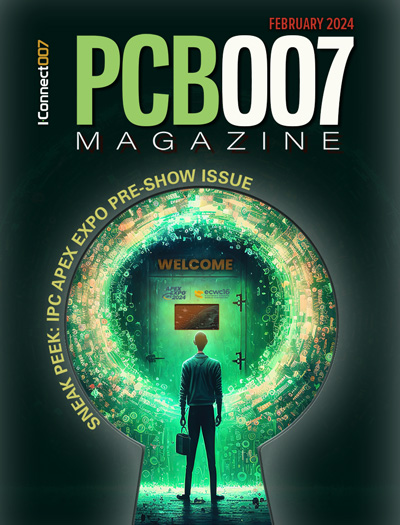-

- News
- Books
Featured Books
- pcb007 Magazine
Latest Issues
Current Issue
The Growing Industry
In this issue of PCB007 Magazine, we talk with leading economic experts, advocacy specialists in Washington, D.C., and PCB company leadership to get a well-rounded picture of what’s happening in the industry today. Don’t miss it.

The Sustainability Issue
Sustainability is one of the most widely used terms in business today, especially for electronics and manufacturing but what does it mean to you? We explore the environmental, business, and economic impacts.

The Fabricator’s Guide to IPC APEX EXPO
This issue previews many of the important events taking place at this year's show and highlights some changes and opportunities. So, buckle up. We are counting down to IPC APEX EXPO 2024.
- Articles
- Columns
Search Console
- Links
- Events
||| MENU - pcb007 Magazine
CES 2020 Automotive: The Future Looks Like a Box
January 9, 2020 | Nolan Johnson, I-Connect007Estimated reading time: 2 minutes
CES week has been true to the themes set forth by Steve Koenig on Sunday, and having spent most of Wednesday in the North Hall of the Las Vegas Convention Center—the automotive pavilion—I can say that Koenig was right: the electric vehicle has reached an inflection point. And along with electric propulsion came autonomous operation.
Electric vehicles were everywhere in the North Hall, taking the place of prominence with many for the major players in the automotive space. But what stood out to me was the two schools of design with respect to emerging autonomous electric vehicles. They were either shoeboxes on wheels or sleek, ultra-stylish, and super-hip vehicles.
Utility vehicles were everywhere on the show floor, ranging from high-capacity people-mover styles to the example application on display at the OSRAM booth: an autonomous vehicle that serves as a mobile parcel locker for packages delivered by shipping companies (e.g., UPS, or DHL, or Amazon).
There were a multitude of takes on the rolling shoe box throughout the show.
Even the Toyota Woven City project depends on such autonomous vehicles for slow-moving, utilitarian, local transport within the city plan. Other companies showing these rolling boxes included Cerence and Fiat Chrysler, among others. But then, things changed.Page 1 of 2
Suggested Items
Siemens’ Breakthrough Veloce CS Transforms Emulation and Prototyping with Three Novel Products
04/24/2024 | Siemens Digital Industries SoftwareSiemens Digital Industries Software launched the Veloce™ CS hardware-assisted verification and validation system. In a first for the EDA (Electronic Design Automation) industry, Veloce CS incorporates hardware emulation, enterprise prototyping and software prototyping and is built on two highly advanced integrated circuits (ICs) – Siemens’ new, purpose-built Crystal accelerator chip for emulation and the AMD Versal™ Premium VP1902 FPGA adaptive SoC (System-on-a-chip) for enterprise and software prototyping.
Elevating PCB Design Engineering With IPC Programs
04/24/2024 | Cory Blaylock, IPCIn a monumental stride for the electronics manufacturing industry, IPC has successfully championed the recognition of the PCB Design Engineer as an official occupation by the U.S. Department of Labor (DOL). This pivotal achievement not only underscores the critical role of PCB design engineers within the technology landscape, but also marks the beginning of a transformative journey toward nurturing a robust, skilled workforce ready to propel our industry into the future.
IPC Design Competition Champion Crowned at IPC APEX EXPO 2024
04/24/2024 | IPCAt IPC APEX EXPO 2024 in Anaheim, California, five competitors squared off to determine who was the best of the best at PCB design.
Altus Group Helps BitBox Unlock Productivity and Efficiency Gains with New Reflow Oven
04/22/2024 | Altus GroupAltus Group, a leading provider of capital equipment, has recently assisted BitBox, a UK-based electronics design, engineering and manufacturing company in upgrading its operations with the implementation of a new reflow oven from Heller Industries.
Real Time with... IPC APEX EXPO 2024: Exploring IPC's PCB Design Courses with Kris Moyer
04/18/2024 | Real Time with...IPC APEX EXPOGuest Editor Kelly Dack and IPC instructor Kris Moyer discuss IPC's PCB design training and education offerings. They delve into course topics such as design fundamentals, mil/aero, rigid-flex, RF design, and advanced design concepts. They also highlight material selection for high-speed design, thermal management, and dissipation techniques. The interview wraps up with details about how to access these courses online.


